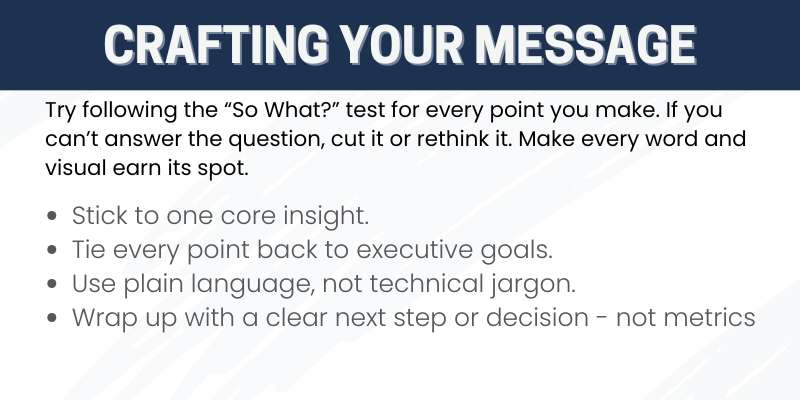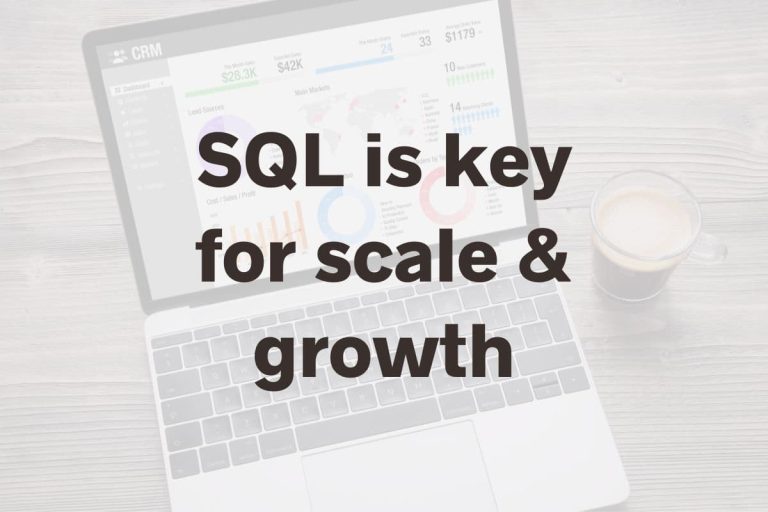How to Communicate With Executives: A Data Analyst’s Guide to Getting Heard
Getting executives to notice your work can feel impossible. We put hours into finding the right data, cleaning it up, finding the nuggets of insight, and it feels like a gamble. Is this the time I get the point across? Will someone DO something with what I’ve found? Learning how to communicate with executives is often the difference between being ignored and becoming a trusted voice.
If you want a seat at the table, mastering this skill matters. Simply put, when you speak the language of decision-makers, you gain influence. That’s how you get your work seen, your ideas heard, and your career moving forward. This post will show you exactly how to break through and get executives on your side.
Understanding the Executive Mindset
No matter how in the weeds you are, grabbing an executive’s attention is not through data-heavy decks. To communicate with executives and actually influence decisions, see the world through their lens. Executives care about results. Analysts who understand the results that matter will stand out.
Priorities That Drive Executive Decisions
Executives are responsible for the company’s health and growth. They measure success differently from analysts buried in spreadsheets and databases.
- Company Goals: Executives care about strategy and company direction. Every project ties back to broad objectives—gaining market share, entering new arenas, beating the competition, or improving customer loyalty.
- KPIs and Scorecards: Success is measured by clear, trackable metrics. Executives focus on KPIs like revenue growth, profit margins, customer retention, and operational efficiency.
- Profitability: Even the best data loses value if it doesn’t show an impact on revenue or costs. They want to know if it helps make or save money. If you can tie what you’re talking about back to that – gold.
When you communicate with executives, show how the work affects company targets and performance. Frame findings as solutions to the problems executives actually lose sleep over.
Common Pitfalls Analysts Face
If you struggle to get your ideas across when communicating with executives or leadership generally, it’s common. Here are mistakes to watch for if you want your message to stick:
- Using Too Much Jargon: Use simple language to show value. We tend to accidentally hide behind technical terms. Executives are experts in business, not in regression analysis or database joins.
- Data Dumps: Flooding a presentation with charts and numbers can overwhelm an audience. Executives want key takeaways, not raw data. Boil down insights to their essence—think “headline,” not “encyclopedia.”
- Missing the Business Impact: Always connect your insights to how they will improve sales, reduce costs, or support strategy. If what you’re working on doesn’t tie to a business goal or outcome, it won’t get noticed.
Always lead with what matters to them, and you’ll find it easier to communicate with executives.
Strategic Preparation: Set Up for Executive Engagement
To communicate with executives, you need to set up as if what you’re communicating is a “pitch”. It should trigger their interest, answers their questions, and helps them reach their goals faster.
This means knowing not just what data you have, but how it connects to what they care about most.
Research Executive Objectives
Knowing what drives the people in any room is mission #1. Executives come to the table focused on what matters to their department and career. If you want to be heard, start by lining up your message with what matters to them.
Here’s how you can make that happen:
- Look to Recent Publications, Notes from Your Meetings: Look at press releases, quarterly earnings, and company newsletters – anything you can get your hands on.
Or what was important in the last conversation you were part of. Managers tend to parrot what they’re hearing is important, so jot down repeat themes or goals from what’s available to you. - Ask Trusted Colleagues: Connect with those who work closely with the leadership your result could impact or that drives the findings. Get their thoughts on what’s most important.
- Review Departmental KPIs: Every executive tracks specific numbers. Frame your insights around the impact to those numbers.
- Spot Personal Wins: Executives are people, too. If you notice one loves innovative projects or getting recognition for efficiency drives, use that angle.
Even better if you were able to tie the potential impact of your work to these end results BEFORE you even start an analysis. It can help drive the right framing as you work through the data.
Crafting a Clear, Impactful Message
Once you know what executives value, turn your data into something that matters as you build out your presentation. And if a literal presentation is what you’re preparing for – You do NOT want to put word-for-word scripts on them!
Here’s a simple approach to build your presentation:
- Lead With the Headline: Start your slide or report with the one big takeaway. If they remember only one thing, what should it be? Put your most important insight at the top, not buried in details.
- Anchor With Impact: Show how the finding affects revenue, expenses, or key business targets.
- Keep It Visual: Use a single, clean chart or graphic. Too many visuals is a distraction.
- End With a Recommendation: Clearly state next steps.

This approach helps you communicate with executives in a way that earns attention and action.
Communicating with Impact in Executive Meetings
Being heard is not about sharing numbers—it’s about the language of value. Your words need to spark interest right away and keep attention on what truly matters when communicating with executives.
Framing the Narrative Around Business Value
To communicate with executives well, always start with the problem & what’s in it for them. Instead of jumping into background, frame every insight as a story about business value. Set the stage with the outcome first, just like a headline, and then fill in the key facts that support it.
When structuring your story or report:
- Open with Impact: Lead with the business problem or opportunity your analysis addresses. Frame it in terms they care about—revenue, cost, or risk.
- Establish the Stakes: Explain why this matters now. Link your insight directly to a business priority or target they track.
- Build to the Evidence: Once you’ve set the business context, share the supporting facts, not before.
- Finish With Direction: End with a clear recommendation or next step. Don’t make executives hunt for your ask.
For example, instead of saying, “Our team analyzed the sales funnel for Q2,” try: “Improving conversion at stage two could add $1.2M to quarterly revenue. Here’s what the data shows, and what we should do next.”
Best practices to keep your message tight:
- Make the business outcome your headline.
- Keep supporting evidence focused and brief.
- Support every “what” with a simple “why now.”
Using Visuals and Analogies for Clarity
Complex analysis loses value if people tune out. Simple visuals and good analogies make your point stick—and help others see what you see.
Easy ways to clarify your message:
- Use one chart or visual per idea. Too many graphs weaken your message.
- Pick simple graph types—bar and line charts often work best.
- Highlight the key number or change, so it stands out.
Handling Pushback and Questions Effectively
When you communicate with executives, expect tough questions. The best way to handle this is to respond with calm, direct answers.
Tips to manage skepticism without losing your message:
- Stay Calm: Don’t rush or get defensive. A measured response shows confidence.
- Acknowledge, Then Redirect: If someone challenges your number, briefly explain the method, then guide the conversation back to business value.
- Have Backup Ready: Bring extra slides with details, but don’t present them unless asked.
- Stick To the Big Picture: If questions dig into the weeds, pull back to the main point—how your analysis will move the needle.
I like to practice redirecting on data quality concerns that might come up. It can derail the whole conversation & lead to a “circle back” moment. Here’s a sample response I try to keep in my back pocket- obviously shifted to the topic at hand:
“That’s a good question—we pulled data from the last three quarters and controlled for outliers to keep trends clear. The key takeaway is this: fixing the bottleneck could speed up revenue by 20%. That’s where the opportunity sits.”
Key approaches to remember:
- Answer facts with facts, then tie back to value.
- Bring backup slides for details but don’t show unless needed.
- Guide conversations back to impact, not process.
When you communicate with executives, clarity and confidence matter, too.
Keep your stories anchored in business value, use tools that make ideas visual and relatable, and handle questions like part of the conversation instead of an obstacle.
This is how you get heard and your message acted on at the highest level.
Becoming a Trusted Advisor
If you want real influence, aim higher than just being “the data person.” Build a long-term reputation as someone executives can rely on for honest insights and steady support. This means playing the long game and showing up the same way, every time.
Key habits set you apart:
- Be consistent: Respond on time, deliver what you said you would, and set realistic expectations. Reliable people get invited back.
- Anticipate needs: Pay attention to what leaders ask for even to others if you have a seat at the table. When you spot something useful send a quick note to show that you think ahead.
- Bring new insights first: Instead of answering the question brought to you, share trends that could help. You have a deep knowledge of what’s in the data, and leaders don’t know what they don’t know.
- Speak their language: Skip analyst jargon.
- Own mistakes: If something turns out wrong, speak up and share next steps to address. Trust grows when you’re honest and don’t hide from errors.
If you’re seen as someone who keeps your word, flags new risks, and brings value, you move from just data support to a partner. And when you reach that level, your ability to communicate with executives multiplies.
Conclusion
Mastering how to communicate with executives shifts your role from data support to influence. By tuning in to what matters to leaders, translating findings into clear business value, and building trust, you become part of the decision-making process.
For data analysts, these skills open doors—your work gets noticed, your ideas drive action, and your career gains momentum. Strive to connect every insight with executive goals and keep your message crisp.


